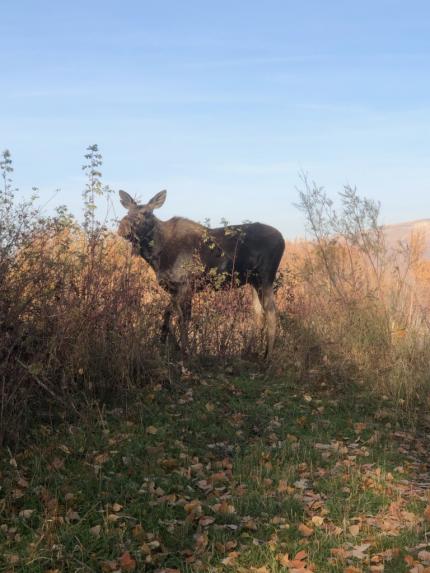ARCHIVED NEWS RELEASE
This document is provided for archival purposes only. Archived documents
do not reflect current WDFW regulations or policy and may contain factual
inaccuracies.
News release Nov. 12, 2019
Devon Comstock, WDFW Acting District Wildlife Biologist 509-665-3391
Staci Lehman, WDFW Public Affairs, 509-892-7853
Neil Neroutsos, Chelan Public Utility District, 509-661-8291
Andrew Fielding, Washington State Parks, 509-668-1138

WENATCHEE, WA – Those visiting the Horan Natural Area in north Wenatchee lately may have encountered a yearling cow moose. The moose most likely wandered into the area after leaving its mother as moose calves generally disperse to find new territory around a year old. Reports of the animal in the area have been frequent since July.
Washington Department of Fish and Wildlife (WDFW) is joining Washington State Parks Department and Chelan County Public Utility District (PUD), who partner to manage the natural area, in making the public aware that they may encounter the moose on or close to trails. While she appears docile, moose are wild animals and should be treated with caution and respect.
To minimize encounters between humans and wildlife in the Horan Natural Area, State Parks, and Chelan PUD will close a section of trail earlier than normal. The main reason for the trail closure is to protect nesting bald eagles, but it also will benefit the moose, as well as people hiking with their dogs.
Moose are not easily spooked and do not fear humans. A minimum safe distance from a moose is at least 50 yards. To avoid close encounters, officials encourage the public to stay safe and remember these tips:
- Keep dogs on leashes and under control. Moose see dogs as predators and may act aggressively towards them.
- Females will defend calves aggressively, so give them a wide berth.
- Be aware of surroundings and avoid surprising a moose.
- If a moose reacts to your presence, you are too close.
- Take photos and watch moose only from a distance – at least 50 yards away.
- Always yield the trail to moose; do not approach them.
- If a moose approaches, back away immediately.
- Be warned that bulls will defend their territory at all times, with increased aggression during the fall mating season, late September through November.
Signs of aggression in moose include raised hair on the neck, lowering the head and putting the ears back, swaying back and forth, snorting, and licking the snout.
If charged by a moose, get behind a large tree, rock, or other object if available, or run away if there is no cover available. If knocked down, get up quickly. If charged by a moose, report the incident to your regional WDFW office as soon as possible.
Moose prefer areas with forest, marshes, and wetlands. As of 2015, there were approximately 5,000 moose in Washington State, with the majority in the Selkirk Mountains and smaller populations in the north Cascades, Okanogan, and Blue mountains. Although they have declined substantially since then in the Selkirks, they appear to have increased in Okanogan and Chelan counties.
The Washington Department of Fish and Wildlife is the primary state agency tasked with preserving, protecting, and perpetuating fish and wildlife and ecosystems, while providing sustainable fishing and hunting opportunities.